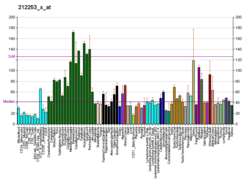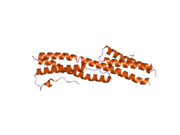Neurologically significant human protein
| DST |
|---|
 |
| Available structures |
|---|
| PDB | Human UniProt search: PDBe RCSB |
|---|
|
|
| Identifiers |
|---|
| Aliases | DST, BPA, BPAG1, CATX-15, CATX15, D6S1101, DMH, DT, EBSB2, HSAN6, MACF2, dystonin, BP230, BP240, EBS3 |
|---|
| External IDs | OMIM: 113810; HomoloGene: 134369; GeneCards: DST; OMA:DST - orthologs |
|---|
| Gene location (Human) |
|---|
 | | Chr. | Chromosome 6 (human)[1] |
|---|
| | Band | 6p12.1 | Start | 56,457,987 bp[1] |
|---|
| End | 56,954,830 bp[1] |
|---|
|
| RNA expression pattern |
|---|
| Bgee | | Human | Mouse (ortholog) |
|---|
| Top expressed in | - corpus callosum
- Achilles tendon
- internal globus pallidus
- pars reticulata
- inferior olivary nucleus
- Pars compacta
- external globus pallidus
- subthalamic nucleus
- inferior ganglion of vagus nerve
- body of uterus
|
| | | More reference expression data |
|
|---|
| BioGPS | 

 | | More reference expression data |
|
|---|
|
| Gene ontology |
|---|
| Molecular function | - calcium ion binding
- protein homodimerization activity
- microtubule plus-end binding
- metal ion binding
- integrin binding
- protein C-terminus binding
- protein binding
- actin binding
- microtubule binding
- structural molecule activity
- cytoskeletal protein binding
| | Cellular component | - cytoplasm
- integral component of membrane
- cell projection
- nuclear envelope
- endoplasmic reticulum membrane
- membrane
- focal adhesion
- microtubule cytoskeleton
- H zone
- plasma membrane
- hemidesmosome
- microtubule plus-end
- basement membrane
- axon
- cell junction
- basal plasma membrane
- cell cortex
- Z disc
- cell leading edge
- endoplasmic reticulum
- actin cytoskeleton
- intermediate filament cytoskeleton
- extracellular exosome
- intermediate filament
- cytoskeleton
- microtubule
- nucleus
- cytosol
- cytoplasmic vesicle
- axon cytoplasm
| | Biological process | - hemidesmosome assembly
- cell motility
- cell adhesion
- response to wounding
- intermediate filament cytoskeleton organization
- integrin-mediated signaling pathway
- maintenance of cell polarity
- microtubule cytoskeleton organization
- retrograde axonal transport
- cytoskeleton organization
- cytoplasmic microtubule organization
- wound healing
| | Sources:Amigo / QuickGO |
|
| Orthologs |
|---|
| Species | Human | Mouse |
|---|
| Entrez | | |
|---|
| Ensembl | | |
|---|
| UniProt | | |
|---|
| RefSeq (mRNA) | NM_001144769
NM_001144770
NM_001144771
NM_001723
NM_015548
|
|---|
NM_020388
NM_183380
NM_001374722
NM_001374729
NM_001374730
NM_001374734
NM_001374736
NM_001386100 |
| |
|---|
| RefSeq (protein) | NP_001138241
NP_001138242
NP_001714
NP_056363
NP_899236
|
|---|
NP_001361651
NP_001361658
NP_001361659
NP_001361663
NP_001361665 |
| |
|---|
| Location (UCSC) | Chr 6: 56.46 – 56.95 Mb | n/a |
|---|
| PubMed search | [2] | n/a |
|---|
|
| Wikidata |
|
Dystonin (DST), also known as bullous pemphigoid antigen 1 (BPAG1), isoforms 1/2/3/4/5/8, is a protein that in humans is encoded by the DST gene.[3][4][5]
This gene encodes a member of the plakin protein family of adhesion junction plaque proteins. Multiple alternatively spliced transcript variants encoding distinct isoforms have been found for this gene, but the full-length nature of some variants has not been defined. It has been known that some isoforms are expressed in neural and muscle tissue, anchoring neural intermediate filaments to the actin cytoskeleton, and some isoforms are expressed in epithelial tissue, anchoring keratin-containing intermediate filaments to hemidesmosomes. Consistent with the expression, mice defective for this gene show skin blistering and neurodegeneration.[5]
Interactions
Dystonin has been shown to interact with collagen, type XVII, alpha 1,[6][7] DCTN1,[8] MAP1B[9] and erbin.[10]
Loss of function in neurological disease
Several Dst mutant mouse lines have been described which share the common feature of having sensory neuron degeneration.[11][12][13] In humans, loss of dystonin function can cause hereditary sensory and autonomic neuropathy type VI[14] and axonal Charcot-Marie-Tooth disease.[15] In both human diseases, pathology is likely attributable to the loss of the dystonin-a2 protein isoform, which plays a role in neuronal autophagy.[16]
See also
References
- ^ a b c GRCh38: Ensembl release 89: ENSG00000151914 – Ensembl, May 2017
- ^ "Human PubMed Reference:". National Center for Biotechnology Information, U.S. National Library of Medicine.
- ^ Stanley JR, Tanaka T, Mueller S, Klaus-Kovtun V, Roop D (December 1988). "Isolation of complementary DNA for bullous pemphigoid antigen by use of patients' autoantibodies". The Journal of Clinical Investigation. 82 (6): 1864–70. doi:10.1172/JCI113803. PMC 442765. PMID 2461961.
- ^ Sawamura D, Nomura K, Sugita Y, Mattei MG, Chu ML, Knowlton R, Uitto J (December 1990). "Bullous pemphigoid antigen (BPAG1): cDNA cloning and mapping of the gene to the short arm of human chromosome 6". Genomics. 8 (4): 722–6. doi:10.1016/0888-7543(90)90261-R. PMID 2276744.
- ^ a b "Entrez Gene: DST dystonin".
- ^ Koster J, Geerts D, Favre B, Borradori L, Sonnenberg A (January 2003). "Analysis of the interactions between BP180, BP230, plectin and the integrin alpha6beta4 important for hemidesmosome assembly". Journal of Cell Science. 116 (Pt 2): 387–99. doi:10.1242/jcs.00241. PMID 12482924. S2CID 16745491.
- ^ Hopkinson SB, Jones JC (January 2000). "The N terminus of the transmembrane protein BP180 interacts with the N-terminal domain of BP230, thereby mediating keratin cytoskeleton anchorage to the cell surface at the site of the hemidesmosome". Molecular Biology of the Cell. 11 (1): 277–86. doi:10.1091/mbc.11.1.277. PMC 14774. PMID 10637308.
- ^ Liu JJ, Ding J, Kowal AS, Nardine T, Allen E, Delcroix JD, et al. (October 2003). "BPAG1n4 is essential for retrograde axonal transport in sensory neurons". The Journal of Cell Biology. 163 (2): 223–9. doi:10.1083/jcb.200306075. PMC 2173519. PMID 14581450.
- ^ Bhanot K, Young KG, Kothary R (November 2011). "MAP1B and clathrin are novel interacting partners of the giant cyto-linker dystonin". Journal of Proteome Research. 10 (11): 5118–27. doi:10.1021/pr200564g. PMID 21936565.
- ^ Favre B, Fontao L, Koster J, Shafaatian R, Jaunin F, Saurat JH, et al. (August 2001). "The hemidesmosomal protein bullous pemphigoid antigen 1 and the integrin beta 4 subunit bind to ERBIN. Molecular cloning of multiple alternative splice variants of ERBIN and analysis of their tissue expression". The Journal of Biological Chemistry. 276 (35): 32427–36. doi:10.1074/jbc.M011005200. PMID 11375975.
- ^ Pool M, Boudreau Larivière C, Bernier G, Young KG, Kothary R (December 2005). "Genetic alterations at the Bpag1 locus in dt mice and their impact on transcript expression". Mammalian Genome. 16 (12): 909–17. doi:10.1007/s00335-005-0073-4. PMID 16341670. S2CID 20415295.
- ^ Young KG, Kothary R (December 2007). "Dystonin/Bpag1--a link to what?". Cell Motility and the Cytoskeleton. 64 (12): 897–905. doi:10.1002/cm.20235. PMID 17849487.
- ^ Lalonde R, Strazielle C (September–December 2023). "The DST gene in neurobiology". Journal of Neurogenetics. 37 (4): 131–8. doi:10.1080/01677063.2024.2319880. PMID 38465459.
- ^ Lynch-Godrei A, Kothary R (February 2020). "HSAN-VI: A spectrum disorder based on dystonin isoform expression". Neurology. Genetics. 6 (1): e389. doi:10.1212/NXG.0000000000000389. PMC 6975176. PMID 32042917.
- ^ Motley WW, Züchner S, Scherer SS (October 2020). "Isoform-specific loss of dystonin causes hereditary motor and sensory neuropathy". Neurology. Genetics. 6 (5): e496. doi:10.1212/NXG.0000000000000496. PMC 7413632. PMID 32802955.
- ^ Ferrier A, De Repentigny Y, Lynch-Godrei A, Gibeault S, Eid W, Kuo D, Zha X, Kothary R (2015). "Disruption in the autophagic process underlies the sensory neuropathy in dystonia musculorum mice". Autophagy. 11 (7): 1025–36. doi:10.1080/15548627.2015.1052207. PMC 4590603. PMID 26043942.
Further reading
- Nakajima D, Okazaki N, Yamakawa H, Kikuno R, Ohara O, Nagase T (June 2002). "Construction of expression-ready cDNA clones for KIAA genes: manual curation of 330 KIAA cDNA clones". DNA Research. 9 (3): 99–106. doi:10.1093/dnares/9.3.99. PMID 12168954.
- Tanaka T, Parry DA, Klaus-Kovtun V, Steinert PM, Stanley JR (July 1991). "Comparison of molecularly cloned bullous pemphigoid antigen to desmoplakin I confirms that they define a new family of cell adhesion junction plaque proteins". The Journal of Biological Chemistry. 266 (19): 12555–9. doi:10.1016/S0021-9258(18)98934-9. PMID 1712022.
- Sawamura D, Li K, Chu ML, Uitto J (September 1991). "Human bullous pemphigoid antigen (BPAG1). Amino acid sequences deduced from cloned cDNAs predict biologically important peptide segments and protein domains". The Journal of Biological Chemistry. 266 (27): 17784–90. doi:10.1016/S0021-9258(18)55195-4. PMID 1717441.
- Sawamura D, Li KH, Nomura K, Sugita Y, Christiano AM, Uitto J (June 1991). "Bullous pemphigoid antigen: cDNA cloning, cellular expression, and evidence for polymorphism of the human gene". The Journal of Investigative Dermatology. 96 (6): 908–15. doi:10.1111/1523-1747.ep12475433. PMID 2045679.
- Owaribe K, Kartenbeck J, Stumpp S, Magin TM, Krieg T, Diaz LA, Franke WW (December 1990). "The hemidesmosomal plaque. I. Characterization of a major constituent protein as a differentiation marker for certain forms of epithelia". Differentiation; Research in Biological Diversity. 45 (3): 207–20. doi:10.1111/j.1432-0436.1990.tb00475.x. PMID 2090522.
- Westgate GE, Weaver AC, Couchman JR (March 1985). "Bullous pemphigoid antigen localization suggests an intracellular association with hemidesmosomes". The Journal of Investigative Dermatology. 84 (3): 218–24. doi:10.1111/1523-1747.ep12265229. PMID 2579167.
- Mutasim DF, Morrison LH, Takahashi Y, Labib RS, Skouge J, Diaz LA, Anhalt GJ (February 1989). "Definition of bullous pemphigoid antibody binding to intracellular and extracellular antigen associated with hemidesmosomes". The Journal of Investigative Dermatology. 92 (2): 225–30. doi:10.1111/1523-1747.ep12276753. PMID 2645368.
- Mutasim DF, Takahashi Y, Labib RS, Anhalt GJ, Patel HP, Diaz LA (January 1985). "A pool of bullous pemphigoid antigen(s) is intracellular and associated with the basal cell cytoskeleton-hemidesmosome complex". The Journal of Investigative Dermatology. 84 (1): 47–53. doi:10.1111/1523-1747.ep12274684. PMID 3880796.
- Nomura K, Sugawara T, Sato T, Sawamura D, Hashimoto I, Sugita Y, Uitto J (1995). "Expression of laminin, type IV procollagen and 230 kDa bullous pemphigoid antigen genes by keratinocytes and fibroblasts in culture: application of the polymerase chain reaction for detection of small amounts of messenger RNA". Archives of Dermatological Research. 286 (7): 408–13. doi:10.1007/BF00371801. PMID 7818282. S2CID 33902783.
- Brown A, Lemieux N, Rossant J, Kothary R (July 1994). "Human homolog of a mouse sequence from the dystonia musculorum locus is on chromosome 6p12". Mammalian Genome. 5 (7): 434–7. doi:10.1007/BF00357004. PMID 7919656. S2CID 324880.
- Hopkinson SB, Jones JC (June 1994). "Identification of a second protein product of the gene encoding a human epidermal autoantigen". The Biochemical Journal. 300 ( Pt 3) (3): 851–7. doi:10.1042/bj3000851. PMC 1138243. PMID 8010969.
- Elgart GW, Stanley JR (August 1993). "Cloning of the 5' mRNA for the 230-kD bullous pemphigoid antigen by rapid amplification of cDNA ends". The Journal of Investigative Dermatology. 101 (2): 244–6. doi:10.1111/1523-1747.ep12365083. PMID 8345227.
- Tamai K, Sawamura D, Do HC, Tamai Y, Li K, Uitto J (August 1993). "The human 230-kD bullous pemphigoid antigen gene (BPAG1). Exon-intron organization and identification of regulatory tissue specific elements in the promoter region". The Journal of Clinical Investigation. 92 (2): 814–22. doi:10.1172/JCI116655. PMC 294919. PMID 8349819.
- Brown A, Dalpé G, Mathieu M, Kothary R (October 1995). "Cloning and characterization of the neural isoforms of human dystonin". Genomics. 29 (3): 777–80. doi:10.1006/geno.1995.9936. PMID 8575775.
- Tang HY, Chaffotte AF, Thacher SM (April 1996). "Structural analysis of the predicted coiled-coil rod domain of the cytoplasmic bullous pemphigoid antigen (BPAG1). Empirical localization of the N-terminal globular domain-rod boundary". The Journal of Biological Chemistry. 271 (16): 9716–22. doi:10.1074/jbc.271.16.9716. PMID 8621649.

 2iak: Crystal Structure of a protease resistant fragment of the plakin domain of Bullous Pemphigoid Antigen1 (BPAG1)
2iak: Crystal Structure of a protease resistant fragment of the plakin domain of Bullous Pemphigoid Antigen1 (BPAG1)

















